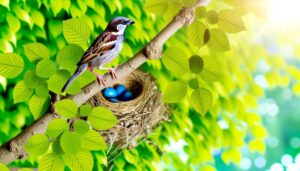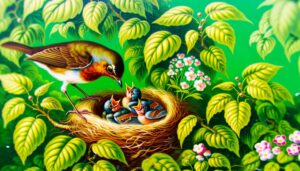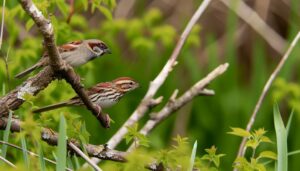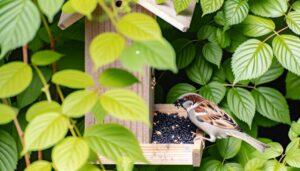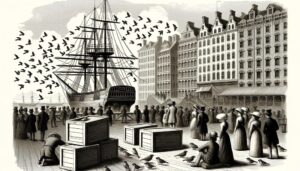7 Simple Steps to Save the House Sparrow
To save house sparrows, prioritize habitat management by providing nesting sites made from natural materials and installing them in safe locations. Use bird feeders near shrubs or trees and offer seeds, grains, and insects as food.
Guarantee fresh water availability through bird baths and create dust baths to support hygiene. Plant native vegetation to supply food and shelter while avoiding pesticides.
Humanely manage predators and educate the public on sparrow conservation. Engage in citizen science projects to monitor populations.
By following these strategies, you'll contribute notably to the survival of house sparrows and discover more ways to aid their conservation.
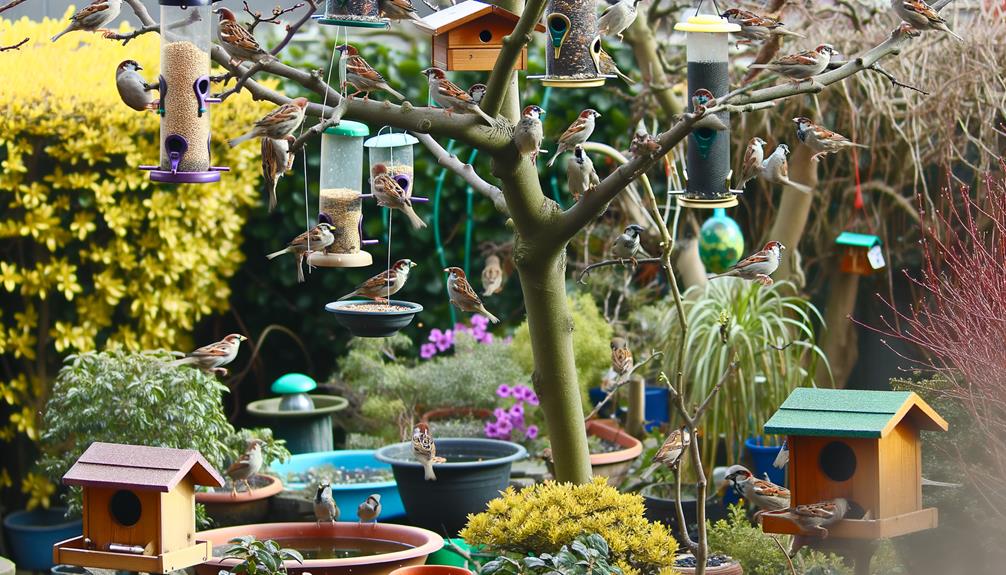
Key Takeaways
- Install nesting boxes in secure locations using natural materials.
- Provide bird feeders with seeds, grains, and insects near shrubs or trees.
- Ensure fresh water availability through bird baths and prevent contamination.
- Plant native vegetation and avoid using pesticides to support sparrow habitat.
- Conduct educational campaigns and engage in citizen science projects for sparrow conservation.
Identify Sparrow Habitats
To effectively identify sparrow habitats, it is crucial to understand their preference for environments that offer abundant food sources, suitable nesting sites, and protection from predators. House sparrows (Passer domesticus) thrive in urban and suburban areas where human activity guarantees a steady supply of grains, seeds, and insects. They are often found near agricultural fields, gardens, and parks. These birds favor habitats that include dense shrubbery or structures with cavities for nesting.
Additionally, the presence of water sources such as ponds or birdbaths is beneficial. Ecologically, sparrows are adaptable and can occupy diverse habitats, but they show a marked preference for areas providing both food and safety, ensuring their survival and reproductive success.
Provide Nesting Sites
Creating suitable nesting sites is essential for the conservation of house sparrows, especially in urban areas where natural habitats are diminished.
Installing nesting boxes made from natural materials can mimic their preferred environments, supporting breeding success.
Additionally, placing these nests in secure, predator-free locations is necessary to guarantee the survival and proliferation of these avian populations.
Install Nesting Boxes
Installing nesting boxes can significantly enhance the availability of suitable nesting sites for house sparrows, thereby contributing to their population recovery. This intervention is particularly vital in urban areas where natural nesting sites are scarce due to modern architectural designs and habitat fragmentation.
To optimize the effectiveness of nesting boxes, consider the following guidelines:
- Location: Place boxes at least 2 meters above ground to avoid predators.
- Orientation: Face the entrance away from prevailing winds to protect from harsh weather.
- Size: Ensure the entrance hole is 32 mm in diameter, ideal for sparrows.
- Maintenance: Regularly clean boxes to prevent disease and parasite buildup.
- Materials: Use untreated wood to provide a safe, natural nesting environment.
These measures are necessary to encourage house sparrows to inhabit the provided nesting boxes.
Use Natural Materials
Utilizing natural materials for constructing nesting sites can create an environment that closely mimics the house sparrow's traditional habitats, promoting their nesting success and overall well-being. Materials such as untreated wood, straw, and natural fibers provide conditions conducive to sparrows' nesting preferences. These elements not only offer structural stability but also facilitate moisture control and temperature regulation, critical to egg incubation and chick rearing.
Ecologically, employing natural materials contributes to sustainable practices, reducing the environmental footprint associated with synthetic alternatives. Detailed observations indicate that sparrows exhibit higher nesting success rates in environments that closely resemble their natural habitats. Hence, the integration of natural materials in nesting site construction is a scientifically-sound method to support the conservation of house sparrows.
Ensure Safe Locations
Securing secure locations for nesting sites is crucial to the survival and proliferation of house sparrows. These sites must be strategically placed to protect from predators and environmental disturbances. Ideal nesting sites should be selected based on several ecological considerations to provide the best chance for successful breeding and rearing of young sparrows.
Here are key factors to optimize safe nesting locations:
- Raised positions: Choose sites at a height to deter ground predators.
- Sheltered spots: Select locations shielded from harsh weather conditions.
- Closeness to food sources: Ensure nests are near abundant food supplies.
- Avoidance of human disruption: Sites should be away from high traffic areas.
- Utilization of natural materials: Incorporate organic materials to blend with the environment.
These measures collectively improve the probability of sparrow survival.
Install Bird Feeders
Strategically situating bird feeders in your garden can greatly contribute to the conservation of house sparrows by providing them with a reliable source of food. Position feeders near shrubs or trees to offer refuge from predators, and make sure they are elevated to prevent access by ground-based threats. This placement mirrors natural foraging conditions, supporting sparrows' ecological needs.
Regularly clean feeders to prevent disease transmission, which can significantly impact sparrow populations. The inclusion of multiple feeders can reduce competition and stress, fostering a more stable environment. Monitoring feeder usage can provide insights into sparrow behavior and population dynamics in your area, enabling more informed conservation efforts.
Proper feeder installation plays an important role in sustaining healthy house sparrow populations.
Choose the Right Food
Selecting appropriate food sources is crucial for supporting the dietary needs of house sparrows and promoting their survival. House sparrows primarily consume seeds, grains, and small insects, which provide crucial nutrients for their health and reproduction.
To effectively nourish these birds, consider offering a variety of food types that cater to their natural diet.
- Millet: Small, protein-rich seeds that are easy for sparrows to consume.
- Cracked corn: Provides necessary carbohydrates and is particularly appealing to sparrows.
- Sunflower seeds: High in fat and energy, beneficial during colder months.
- Mealworms: Provide essential protein and are ideal for feeding young sparrows.
- Oats: A versatile grain that can be offered alone or mixed with other seeds.
Providing these food sources can greatly aid in the conservation of house sparrow populations.
Ensure Fresh Water
Ensuring a reliable source of fresh water is essential for the survival and well-being of house sparrows, especially in urban environments where natural water sources are often limited.
Daily provision of clean water, facilitated through strategically placed bird baths, can greatly improve their hydration and overall health.
Additionally, measures to prevent water contamination are vital to maintain the quality of their drinking sources and to avoid the spread of waterborne diseases.
Provide Clean Water Daily
Access to clean, fresh water daily is essential for the survival and health of house sparrows, as it supports their hydration needs and helps maintain their overall well-being. Regular access to uncontaminated water is necessary for metabolic processes and thermoregulation, particularly in urban environments where natural water sources may be scarce or polluted.
To facilitate this, consider the following actions:
- Change water frequently to prevent stagnation and bacterial growth.
- Use shallow containers to accommodate the small size of sparrows.
- Place water sources in shaded areas to keep water cool and reduce evaporation.
- Ensure water is free of chemicals like chlorine or pesticides.
- Monitor water quality to prevent the spread of diseases.
Implementing these measures effectively supports house sparrow populations.
Install Bird Baths
Providing house sparrows with a reliable source of fresh water can be further supported by installing bird baths in your garden or balcony. Bird baths serve as a crucial resource, particularly in urban environments where natural water sources may be scarce.
These installations not only quench the birds' thirst but also facilitate important behaviors such as bathing, which helps in maintaining their plumage. For best effectiveness, bird baths should be shallow, with a depth of 2-3 inches, and positioned in a shaded area to prevent overheating.
Additionally, the presence of perches or textured surfaces can assist sparrows in accessing the water with ease. Regularly refreshed water will secure the sustainability of this essential resource for house sparrows.
Prevent Water Contamination
To maintain the health and well-being of house sparrows, it is essential to implement measures that prevent water contamination in bird baths. Providing consistently clean water is pivotal, as contaminated water can harbor pathogens detrimental to sparrows.
Key strategies include:
- Regular Cleaning: Clean bird baths at least once a week to remove algae and debris.
- Fresh Water: Refill with fresh, uncontaminated water daily.
- Location: Place bird baths away from potential contaminants like pesticides or fertilizers.
- Monitor: Regularly check for signs of contamination, such as discoloration or odor.
- Safe Materials: Use non-toxic materials for bird baths to prevent chemical leaching.
These measures foster a safe hydration environment, ensuring the ecological integrity necessary for the thriving of house sparrow populations.
Plant Native Vegetation
Often, the cultivation of indigenous vegetation proves vital in creating sustainable habitats for house sparrows. These plants provide the necessary food and shelter that align with the birds' ecological requirements. Native plants support a diverse insect population, which is an essential food source for sparrow chicks. Moreover, these plants produce seeds and fruits that are integral to the sparrow's diet.
Avoid Pesticides
The use of pesticides poses a significant threat to house sparrows, as these chemicals can contaminate their food sources and disrupt the ecological balance essential for their survival. Pesticides can reduce insect populations, which are a critical food source for sparrow chicks. Additionally, chemical residues can accumulate in sparrows, leading to direct toxicity or sub-lethal effects that impair reproduction and survival.
To support house sparrows, consider the following recommendations:
- Use organic farming practices to minimize chemical exposure.
- Promote integrated pest management (IPM) strategies, which emphasize natural pest control methods.
- Encourage the planting of pest-resistant plants to reduce the need for chemical interventions.
- Advocate for pesticide-free public spaces to create safe habitats.
- Educate communities on the ecological impacts of pesticide use.
Create Dust Baths
Creating dust baths provides house sparrows with a necessary means to maintain their plumage health by removing parasites and excess oils. These avian hygiene practices are vital for the birds' thermoregulation and overall well-being.
To establish an effective dust bath, choose a location with loose, dry soil, free from pesticides and contaminants. The ideal bath area should be approximately 50 cm in diameter and 5 cm deep, ensuring sufficient space for multiple birds.
Regularly monitor and replenish the dust bath to maintain its efficiency, especially after rainfall when the soil becomes compacted. Additionally, incorporating fine sand into the soil mixture can enhance the dust bath's texture, improving its usefulness for the sparrows.
A well-maintained dust bath can greatly contribute to the ecological support of house sparrow populations.
Manage Predators
Managing predators is crucial for safeguarding house sparrow populations, as it directly impacts their survival and reproductive success. Effective predator management involves understanding the ecological context and implementing practices that mitigate predation risks.
Key strategies include:
- Habitat Modification: Maintain dense vegetation and shrubbery to provide cover and nesting sites.
- Predator Control: Implement humane measures to control populations of invasive species, such as feral cats and rats.
- Nest Box Design: Use sparrow-specific nest boxes with small entrance holes to deter larger predators.
- Monitoring: Regularly check and maintain nesting sites to make certain they remain safe from predators.
- Education and Awareness: Inform local communities about the impact of domestic pets and encourage responsible pet ownership.
These efforts collectively enhance the house sparrow's ability to thrive.
Participate in Citizen Science
Engaging in citizen science initiatives, such as sparrow monitoring programs, enables individuals to contribute valuable data on house sparrow populations.
By recording sparrow sightings and behaviors, participants can provide critical insights into population trends and habitat use.
This shared data becomes an indispensable resource for researchers working to develop effective conservation strategies.
Join Sparrow Monitoring Programs
Participating in sparrow monitoring programs as part of citizen science initiatives provides valuable data for understanding population dynamics and ecological trends. These programs harness public involvement to collect extensive, geographically diverse data sets essential for scientific research. Engaging in these initiatives can help identify critical factors impacting house sparrow populations.
Key contributions of monitoring programs include:
- Tracking population sizes: Observing changes in sparrow numbers over time.
- Habitat analysis: Identifying and documenting preferred habitats and nesting sites.
- Behavioral studies: Observing and recording sparrow behavior and interactions.
- Impact assessment: Evaluating the effects of urbanization and environmental changes.
- Conservation efforts: Informing targeted conservation strategies and policies.
Such initiatives bridge the gap between scientific research and public participation, fostering a collaborative approach to conservation.
Record Sparrow Sightings
By documenting sparrow sightings through citizen science platforms, individuals contribute to the thorough mapping of species distribution and population trends. This systematic recording provides critical data that aids in understanding the ecological health of habitats.
Observations should include detailed notes on behavior, nesting sites, and environmental conditions. Importantly, platforms such as eBird and iNaturalist offer user-friendly interfaces for logging sightings, enabling widespread participation.
Accurate data collection helps in identifying factors contributing to population declines, such as habitat loss or pollution. Seasonal variations and migration patterns can be better understood through consistent reporting.
Engaging in this citizen science initiative empowers individuals to play an active role in conservation efforts, fostering a deeper connection with local biodiversity.
Share Data With Researchers
Sharing the carefully recorded sparrow sightings with researchers enhances the impact of citizen science efforts by providing crucial data that can inform conservation strategies. This data helps scientists grasp population trends, habitat preferences, and threats to sparrows' survival.
Engaging in citizen science projects guarantees that data is strong and geographically varied, enabling an all-encompassing analysis.
Key data points to share include:
- Date and time of sighting
- Precise location (GPS coordinates if possible)
- Number of sparrows observed
- Behavioral observations (feeding, nesting, etc.)
- Photographic evidence
Spread Awareness
Raising public awareness about the declining population of house sparrows is essential for fostering community-driven conservation efforts.
Effective dissemination of information through educational campaigns, social media, and public forums can illuminate the ecological significance of these birds. Highlighting their role in pest control and pollination can underscore their importance within urban ecosystems.
Detailed observation and data sharing can further illustrate the troubling decrease in their numbers due to habitat loss and pollution.
Encouraging schools to incorporate sparrow conservation in their curriculum and engaging local communities in citizen science projects can create a well-informed public.
Such grassroots initiatives are critical for implementing practical solutions, like creating sparrow-friendly habitats, thereby ensuring the survival of this iconic avian species.
Conclusion
The preservation of house sparrows necessitates an integrated approach encompassing:
- Habitat identification
- Provision of nesting sites
- Strategic placement of bird feeders with appropriate food
- Ensuring access to fresh water
Additionally, the creation of dust baths, management of predators, and active participation in citizen science projects are essential.
By understanding the ecological significance of house sparrows and promoting widespread awareness, the decline of this species can be mitigated.
Future research must further explore the correlation between urbanization and sparrow population dynamics to develop effective conservation strategies.

